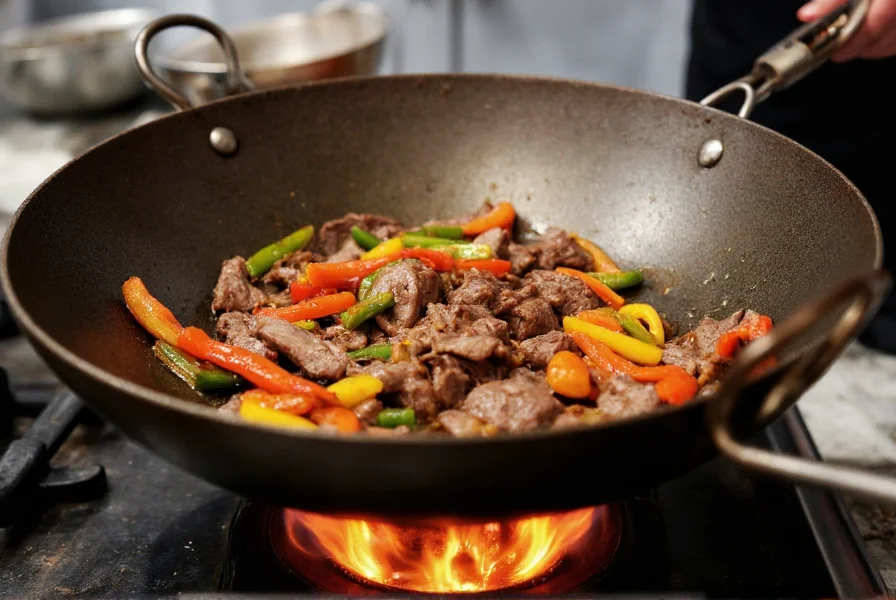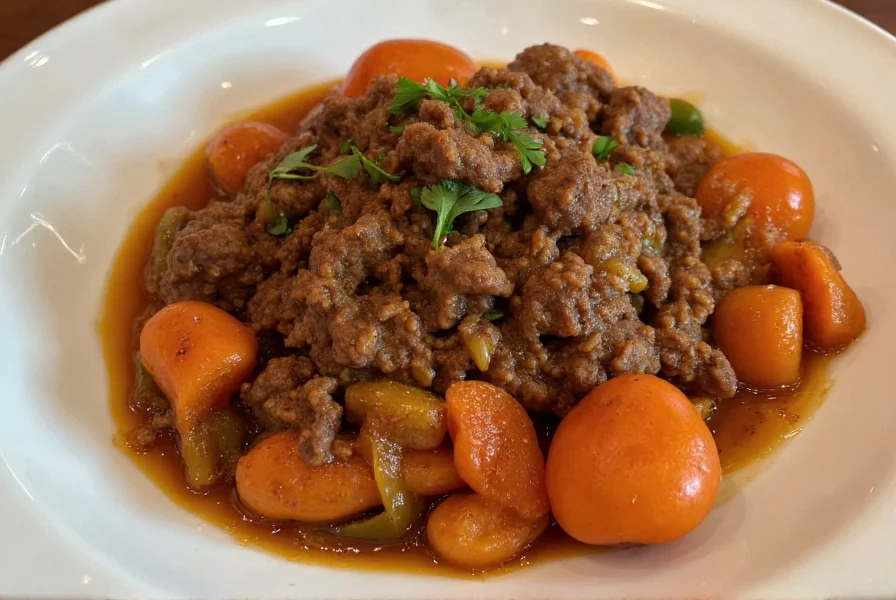The perfect pepper beef recipe features tender slices of flank steak stir-fried with vibrant bell peppers and onions in a rich, savory-sweet sauce made from soy sauce, oyster sauce, and a hint of garlic. This authentic Chinese-American classic takes just 30 minutes to prepare, yields 4 servings, and achieves restaurant-quality results when you properly slice the beef against the grain, marinate for at least 15 minutes, and use high-heat cooking techniques to prevent overcooking.
Creating exceptional pepper beef requires understanding the balance between texture, flavor, and timing. This beloved stir-fry dish originated in Chinese-American cuisine and has become a staple in takeout menus across North America. The magic happens when you combine properly prepared beef with crisp-tender vegetables and a glossy sauce that clings perfectly to every ingredient.
Why This Pepper Beef Recipe Works
Unlike many simplified versions, this authentic pepper beef recipe incorporates professional techniques that guarantee tender meat and restaurant-quality results. The key lies in the velveting process—a Chinese cooking method that protects the beef during high-heat cooking. By using a combination of cornstarch, egg white, and rice wine in the marinade, you create a protective barrier around each piece of meat that locks in juices while promoting beautiful searing.
Essential Ingredients for Authentic Flavor
The quality of your ingredients directly impacts the final dish. Here's what you'll need for the best pepper steak stir fry:
| Ingredient | Amount | Why It Matters |
|---|---|---|
| Flank steak or sirloin | 1½ pounds | Cut against the grain for maximum tenderness |
| Bell peppers (mixed colors) | 3 medium | Vibrant colors and crisp texture when properly cooked |
| Yellow onion | 1 large | Sweetness balances the savory sauce components |
| Soy sauce (low sodium) | 3 tablespoons | Provides umami foundation without overwhelming saltiness |
| Oyster sauce | 2 tablespoons | Creates rich, complex flavor base essential for authentic taste |
| Sesame oil | 1 teaspoon | Adds distinctive aroma—never cook with it, only finish with it |
Professional Equipment Recommendations
While you can make pepper beef in a standard skillet, a carbon steel wok delivers superior results. The curved shape allows for proper heat distribution and makes tossing ingredients effortless. If using an electric stove, a flat-bottom wok works best. You'll also need:
- Sharp chef's knife for precise meat slicing
- Mandoline slicer (optional but helpful for uniform vegetables)
- Wooden or metal spatula for stirring
- Small bowls for mise en place (prepped ingredients)

Step-by-Step Cooking Instructions
Preparing the Beef
Slice the beef against the grain into ¼-inch thick pieces—this cuts through the muscle fibers for maximum tenderness. Combine with 1 tablespoon soy sauce, 1 tablespoon Shaoxing wine, 1 egg white, and 1 tablespoon cornstarch. Massage gently for 1 minute until the liquid is absorbed and the mixture becomes slightly sticky. Refrigerate for 15-30 minutes while preparing other ingredients.
Creating the Perfect Sauce
In a small bowl, whisk together 2 tablespoons soy sauce, 2 tablespoons oyster sauce, 1 tablespoon rice vinegar, 1 tablespoon brown sugar, 1 teaspoon sesame oil, and ¼ cup beef broth. This balanced sauce provides the sweet-savory profile characteristic of the best pepper beef stir fry recipes.
Stir-Frying Technique
- Heat your wok over high heat until smoking hot (about 2 minutes)
- Add 2 tablespoons vegetable oil and swirl to coat
- Working in batches, stir-fry beef for 60-90 seconds until just browned but not fully cooked
- Remove beef and set aside
- Add 1 tablespoon oil and stir-fry onions for 30 seconds
- Add bell peppers and cook for 1-2 minutes until crisp-tender
- Return beef to wok and pour in sauce
- Stir constantly for 60 seconds until sauce thickens and coats ingredients
Variations for Different Dietary Needs
This versatile pepper steak stir fry adapts well to various preferences:
- Gluten-free version: Substitute tamari for soy sauce and ensure oyster sauce is GF (or use mushroom sauce)
- Low-sodium option: Use reduced-sodium sauces and increase garlic/ginger for flavor
- Spicy pepper beef: Add 1-2 chopped Thai chilies or 1 teaspoon chili garlic sauce
- Vegetarian alternative: Replace beef with extra-firm tofu or seitan, using same marinade technique
Serving Suggestions for Complete Meal
Pepper beef shines when served immediately over steamed jasmine rice. For a restaurant-style presentation:
- Use a wide, shallow bowl to showcase the colorful ingredients
- Sprinkle with toasted sesame seeds and thinly sliced green onions
- Accompany with a simple cucumber salad to balance richness
- Pair with hot mustard or chili oil for dipping
Storage and Reheating Guidelines
While pepper beef tastes best fresh, leftovers keep well for 3-4 days in an airtight container. For optimal reheating:
- Stovetop method: Heat in a wok with 1-2 teaspoons water to revive sauce
- Microwave alternative: Cover and heat in 30-second intervals, stirring between
- Never freeze pepper beef as the vegetables become mushy upon thawing
Troubleshooting Common Issues
Even experienced cooks encounter challenges with this seemingly simple dish. Here's how to solve frequent problems:
- Chewy beef: You didn't slice against the grain or overcooked the meat
- Watery sauce: Didn't cook on high enough heat or used too much liquid
- Mushy vegetables: Cooked peppers too long or added them too early
- Bland flavor: Insufficient marinating time or low-quality sauces
Why Traditional Techniques Matter
Many home cooks skip the velveting process, but this professional technique makes all the difference in achieving tender beef for stir fry. The cornstarch creates a protective coating that prevents the meat from overcooking during the brief high-heat cooking. Similarly, proper knife skills ensure uniform pieces that cook evenly—thick slices remain undercooked while thin pieces become tough.
Frequently Asked Questions
Can I make pepper beef without cornstarch?
While cornstarch helps tenderize the beef and thicken the sauce, you can substitute arrowroot powder or omit it entirely. Without cornstarch, marinate the beef with 1 teaspoon baking soda for 15 minutes, then rinse thoroughly before cooking. This alternative method also helps tenderize the meat through pH modification.
What's the best cut of beef for pepper steak stir fry?
Flank steak and sirloin are ideal for pepper beef recipes due to their flavor and ability to remain tender when properly sliced against the grain. For even more tender results, consider ribeye or tenderloin, though these premium cuts increase the cost. Avoid tough cuts like chuck that require long braising times.
How can I prevent my pepper beef from becoming soggy?
Sogginess occurs when ingredients release too much moisture during cooking. To prevent this: 1) Ensure your wok is extremely hot before adding oil 2) Cook beef in batches without overcrowding 3) Slice vegetables uniformly for even cooking 4) Use high-heat cooking oil like peanut or canola 5) Never cover the wok while stir-frying. The key is maintaining high heat throughout the cooking process.
Can I prepare pepper beef ahead of time for meal prep?
Yes, but with proper technique. Marinate the beef and store separately from the sauce and vegetables. When ready to eat, cook the beef first, then vegetables, then combine with sauce. Pre-cooked pepper beef loses its crisp texture if stored together, so keep components separate until ready to serve for best results in meal prep scenarios.
Why does my pepper beef sauce separate?
Sauce separation typically happens when the cornstarch hasn't properly activated or when the heat is too low. To fix this: 1) Ensure your sauce ingredients are at room temperature before adding 2) Mix cornstarch with cold liquid before adding to hot ingredients 3) Maintain high heat when adding sauce 4) Stir constantly in a figure-eight motion. The sauce should thicken almost immediately upon contact with the hot ingredients.











 浙公网安备
33010002000092号
浙公网安备
33010002000092号 浙B2-20120091-4
浙B2-20120091-4